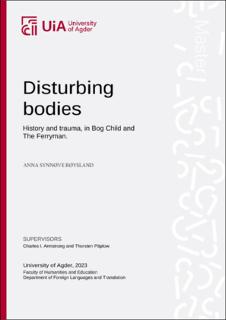Disturbing bodies: History and trauma, in Bog Child and The Ferryman
| dc.contributor.advisor | Armstrong, Charles I. | |
| dc.contributor.advisor | ||
| dc.contributor.advisor | Päplow, Thorsten | |
| dc.contributor.author | Røysland, Anna Synnøve | |
| dc.date.accessioned | 2023-07-25T16:23:21Z | |
| dc.date.available | 2023-07-25T16:23:21Z | |
| dc.date.issued | 2023 | |
| dc.identifier | no.uia:inspera:143823775:3242269 | |
| dc.identifier.uri | https://hdl.handle.net/11250/3081298 | |
| dc.description.abstract | Trauma theory is a growing field that continues to be researched by many and the use of literature as a medium for trauma theory is a field that continues to expand. The image of bodies is prominent in both the novel Bog Child by Siobhan Dowd and the play The Ferryman by Jez Butterworth. It is fascinating to look at how the image of bodies is used in these two literary works and how it can be connected to both history and trauma theory. The body used as a symbol is one of the most important aspects of the thesis: the body as in a corpse, but also the way in which one can use a living body in a symbolic way as they have done in the hunger strikes. Trauma theory can be connected to many aspects of both Bog Child and The Ferryman, and both the bog bodies and the hunger strikers play very important roles in the lives of the main characters. The closely connected role of historic events in the novel and in the play does so that the trauma theory has a prominent role in the analysis of both. | |
| dc.description.abstract | ||
| dc.language | ||
| dc.publisher | University of Agder | |
| dc.title | Disturbing bodies: History and trauma, in Bog Child and The Ferryman | |
| dc.type | Master thesis |
Tilhørende fil(er)
Denne innførselen finnes i følgende samling(er)
-
Master's theses in Advanced Teacher Education, level 8-13 [232]
EN-505, HI-501, IDR513, MA-502, NO-505, REL501, SV-505
